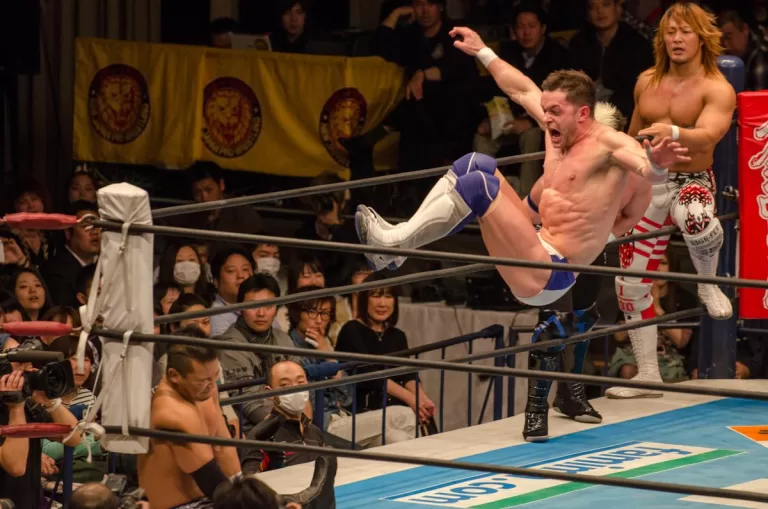NJPW is the biggest wrestling promotion in Japan and the biggest in the world not called WWE. In recent years, the company’s exposure to fans outside of Japan has risen exponentially thanks to the high amount of ‘gaijin’ (foreign) talent on their roster – especially the Young Bucks, who have become masters at marketing independent wrestling…
NJPW has been around longer than Vincent Kennedy McMahon’s WWE/F. In the modern era, to speak of New Japan is to speak of Hiroshi Tanahashi, the “Ace” of New Japan Pro Wrestling. Many consider Tanahashi to be the Japanese John Cena given how both carried their respective companies during a time when other stars were few and far between. The company was founded in 1972 by Japanese legend Antonio Inoki; the same Inoki who came to Pakistan to wrestle Akram Pehalwan in 1976.
Going back to WWE, there have been many wrestlers in recent years who have crossed the divide and wrestled for both companies on their big shows. Chris Jericho is a very recent example, while AJ Styles and Shinsuke Nakamura have both squared off at the Tokyo Dome and at WrestleMania for the WWE World Heavyweight Championship.
Wrestling Style:
New Japan’s in-ring action is generally a more stiff and hard-hitting affair. Stars like Ishi and Minoru Suzuku are renowned for their rugged and rough wrestling mannerisms, also called ‘strong-style’. However, NJPW isn’t, and hasn’t always been, all about strong-style wrestling.
IWGP Intercontinental belt or not, Suzuki-Gun Boss @suzuki_D_minoru is still laser focused on dealing as much pain as possible on @s_d_naito! Watch now▶︎https://t.co/Tj7UBINesh#njDONTAKU #NJPWWorld pic.twitter.com/WPk6ANWtcP
— njpwworld (@njpwworld) May 3, 2018
Also, during New Japan matches, wrestlers are subject to a 20-count, instead of the regular 10-count we see in the WWE, when they are outside of the ring and the champion can lose their title if they are counted out.
Presentation:
Japanese crowds are very silent and that is largely down to their culture rather than their disinterest in the show. At first glance, this particular difference can be incredibly striking for a first-time viewer of NJPW. The crowd generally responds to the in-ring action as if they’re watching a movie, only showing emotion at the right moments.
WWE generally relies heavily on in-ring promos, backstage skits, enormous pyro and over-the-top production. There is also an emphasis on acting, comedy, and the branding of everything – whereas New Japan is more traditional with respect to its production style. Most of the shows are in Japanese but the in-ring storytelling works so effectively around the language barrier that anyone watching the show is able to understand the story.
The turnbuckle pads in a New Japan ring are more like those in a boxing ring, with a single pad instead of the three separate ones we see in the WWE.
Young Lions:
Matches in New Japan are surrounded by the ‘Young Lions’, who are trainees gaining valuable experience by getting a first-hand look at some action. These Young Lions often try to get involved in matches if the wrestlers go too far and have been beaten up by nasty heels like Minoru Suzuki. This is said to be their initiation.
Once their training in Japan is complete, they are often sent to affiliated companies in the West like Mexico’s CMLL or, in the past, TNA and Ring of Honor. Upon returning from these excursions, the Young Lions usually get a push if they are deemed good enough and possibly join one of the existing factions. For example, “Switchblade” Jay White teased joining the Bullet Club before turning on Kenny Omega and joining Chaos and Kazuchika Okada.
Schedule:
NJPW presents itself as a sporting event so tournaments are aplenty.
The biggest show of the year is on January 4th of every year and is called WrestleKingdom, taking place at the Tokyo Dome. WrestleKingdom is the culmination of all the stories that have played out in the past year, while also starting off new stories for the new year. Main eventing the Tokyo Dome, just like main eventing WrestleMania, is a huge achievement.
NJPW has a major show for each season, and a few other small ones throughout the year. Most of these are on the level of a non-big four WWE pay-per-view. The biggest NJPW shows post-WrestleKingdom are The New Beginning (February), Wrestling Dontaku (May), Dominion (June), Destruction (Sept), King of Pro Wrestling (Oct) and Power Struggle (Nov).
However, New Japan is not all about its big-name PPV shows as the tournaments that the company organises hold just as much significance as any other show throughout the year. The biggest tournaments that take place during the year in NJPW are: the World Tag League, the New Japan Cup, Best of the Super Juniors, the Super J Cup, and the Super Juniors Tag tournament. However, the grandest tournament is the prestigious G1 Climax. The G1 Climax is a 4-week round robin tournament where the winner, in recent years, has gone on to face the IWGP Heavyweight Champion at WrestleKingdom in January. This can be considered the equivalent of the WWE’s Royal Rumble, in which the winner goes on to challenge the Heavyweight Champion at WrestleMania.
Most of New Japan’s tournaments take place in round-robin format, with the exception of the New Japan Cup, which is a single knockout tournament like the WWE’s King of the Ring.
5* Matches:
We are only five months into 2018 and NJPW has already been awarded four 5* or higher matches by respected wrestling journalist, Dave Meltzer, of the Wrestling Observer Newsletter. To put things into perspective, this is the same number of 5* matches that WWE has had in the last eight years.
In June 2017, Kazuchika Okada and Kenny Omega’s match at Dominion was awarded 6.25*s out of 5 by Meltzer. while seven other matches received a 5* or higher rating from New Japan. The quality of matches that NJPW puts out is unparalleled anywhere in the world.
